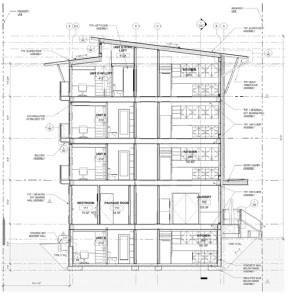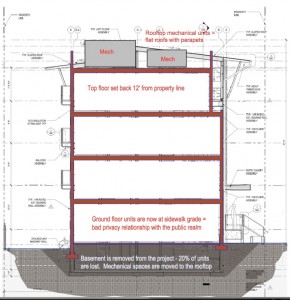Why We Appealed the Low-Rise Downzone
This post originally appeared on July 1st of this year. I am reposting it because today we get to make our case before the City’s Hearing Examiner. We think we have a good case that shows that the Department of Planning and Development failed to adequately address the environmental impacts of what amounts to a serious downzone of the low-rise. I’ll write more when I can about the process as it unfolds today.
The legislation put forward by the Department of Planning and Development to “fix” things in Seattle’s low rise zones can only be understood as a downzone. To understand why, it’s important to understand how FAR works. The proposed legislation in response to a request from Councilmember Clark ends up in reducing FAR the low-rise zones, a reduction that takes away housing capacity. It does this by affecting the way FAR gets calculated in the zone.
Floor Area Ratio, or as it usually known, FAR, is a measure of how much living space can be on a piece of land. For example, if the code allows 20,000 square feet of living space on a lot that is 10,000 square feet, the FAR on that lot would be expressed as 2. The general rule is that all enclosed spaces are included in FAR. So interior stairways and hallways are included as FAR, but exterior hallways and stairways are not. Partially below grade spaces are not counted as FAR, most commonly used for parking mechanical storage bike rooms laundry and less expensive basement units.
20,000 square feet living space = 2
10,000 square feet of lot
The higher the number, the more livable space is allowed on a lot. This means that FAR is also a measure of density and height since more living space can mean more people and with more living space allowed, heights also go up. With more height, a designer and builder can configure living space in a way that lowers lot coverage and enables them to plan for set backs, open space, or other design features. Using FAR is a flexible way of increasing density without being overly prescriptive about how the space is configured.
The DPD proposal tries to appease neighbors angry about what they see as buildings that are too tall in the low-rise zones, especially in the LR 3, the zone that allows the highest densities. It does this by adding more spaces into what gets included in living space. So in the above example, the numbers stay the same but things like basement areas, crawl spaces, and parking get lumped into that 20,000 number.
Instead of 20,000 square feet of living space, the 20,000 includes lots of spaces that people can’t live in; that means smaller units or fewer units, or fewer amenities like parking, laundry, bike storage, etc.
With more living space, a project has more space that can be sold or rented. That means FAR is also a measure of financial opportunity and risk. With a higher FAR, a developer can create more units, for example, but she also would have additional costs and risks with building more.
What effects does FAR have on rents and costs to consumers? All development projects use borrowed money, or money that has to be paid back either at the end of the project or over time. Rents generate the income stream to pay that money back and pay for operations of the building. More FAR can lower rents because a builder can create more units and spread those costs among more units.
Rents are driven by the supply and demand, but with more FAR a builder can more efficiently and competitively spread those costs and offset the risks of building higher or building more. But more FAR doesn’t necessarily mean more profit since any development is a careful calibration of costs, what the market allows for rent, and what is feasible on a site; higher FAR does mean that more people can live on a smaller footprint.
Keeping the FAR number the same but adding more things considered living space in the calculation is a kind of sneaky way to downzone the low-rise zones. It means fewer units will be built, which means less housing. Many projects that work using today’s calculations just won’t work. They either wouldn’t get built or they would be downsized. It also means that energy efficiency measures that rely on configuring space differently won’t be feasible.
And here’s the other downside of the downzone: the proposal won’t really affect the size of buildings, just the number of units. Here’s a sketch of what a project in the LR3 Zone would look like before and after the downzone.
As you can see the overall scale of the building is unaffected, but there is a loss of 20 percent of the units.
This is why we’ve appealed the Determination of Non Significance (DNS) made by DPD on this legislation they’ve drafted. The proposal deliberately takes space away from housing use, which won’t really reduce the size of buildings, but will make some projects unbuildable, reducing overall housing supply and increasing prices; which is what the neighborhood wanted after all, no more people and no more building.




